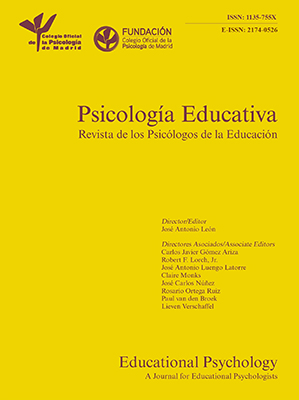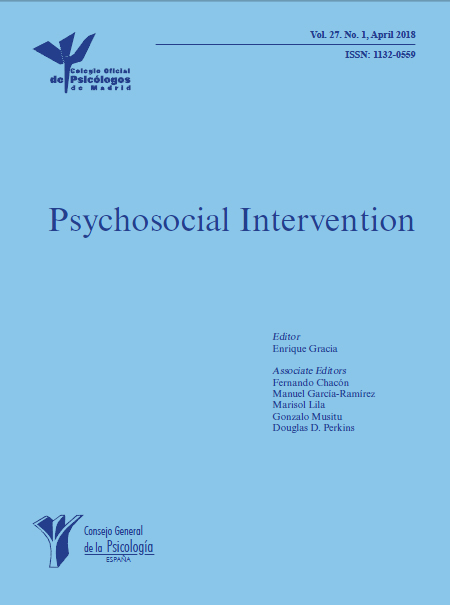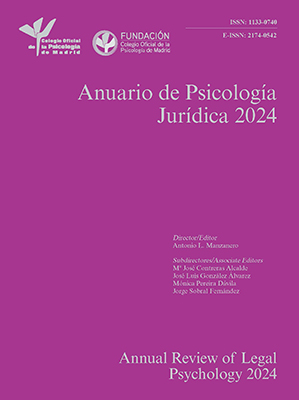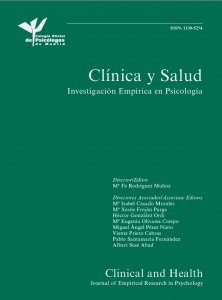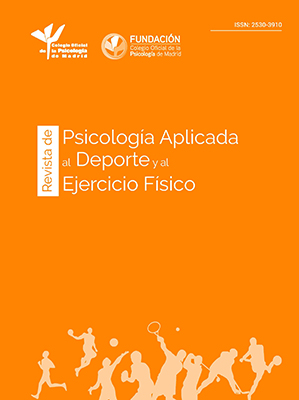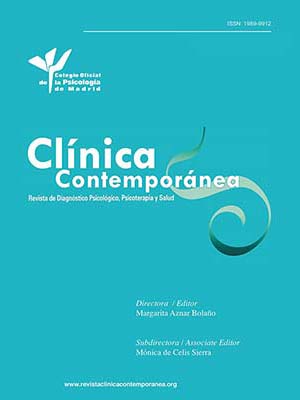
Subjective Well-being and the Prediction of Dimensions of Academic Performance
[El bienestar subjetivo y la predicción de las dimensiones del desempeño académico]
Tania París, Inmaculada Otero, & Silvia Moscoso
University of Santiago de Compostela, Spain
https://doi.org/10.5093/jwop2025a10
Received 13 May 2025, Accepted 18 July 2025
Abstract
Previous literature has highlighted the relevance of subjective well-being (SWB) and academic performance (AP) in predicting job performance. However, less research has been focused on the relationship between SWB and AP. This study examines the relationship of SWB and its components (cognitive and affective) and overall AP, as well as its dimensions (task, contextual, counterproductive, and innovative academic performance). We also examine whether there are sex differences in these variables. The sample consists of 328 university students. The results show that: (1) the cognitive component of SWB (i.e., life satisfaction) correlates with the four dimensions of AP as well as with overall AP; (2) the affective component of SWB correlates with overall AP and with some of its dimensions; (3) significant sex differences were found in the affective component, but not in the cognitive component, of SWB; (4) significant differences between males and females in AP and its dimensions were also found (except in innovative performance); (5) life satisfaction and sex explain up to 20% of the variance in AP and its dimensions. Finally, the theoretical and practical implications of the results are discussed and new avenues for future research are suggested.
Resumen
La literatura previa ha destacado la importancia del bienestar subjetivo (BS) y el desempeño académico (DA) para predecir el desempeño laboral. Sin embargo, se ha investigado menos la relación entre el bienestar subjetivo y el desempeño académico. Este estudio analiza la relación entre el BS y sus componentes (cognitivo y afectivo) y el DA global, así como sus dimensiones (tarea, contextual, contraproductivo e innovador). También se examina si existen diferencias en función del sexo en estas variables. La muestra está formada por 328 estudiantes universitarios. Los resultados muestran que: (1) el componente cognitivo del BS (es decir, satisfacción con la vida) correlaciona con las cuatro dimensiones del DA y con el DA global, (2) el componente afectivo del BS correlaciona con el DA general y con algunas de sus dimensiones, (3) se observaron diferencias significativas en función del sexo en el componente afectivo del BS pero no en el cognitivo, (4) también se observaron diferencias significativas entre hombres y mujeres en el DA y sus dimensiones (excepto en el desempeño innovador) y (5) la satisfacción con la vida y el sexo de la persona explican hasta el 20% de la varianza del DA y sus dimensiones. Por último, se abordan las implicaciones teóricas y prácticas de los resultados y se sugieren nuevas líneas para futuras investigaciones.
Palabras clave
Bienestar subjetivo, Satisfacción con la vida, Desempeño académico, Diferencias en función del sexoKeywords
Subjective well-being, Life satisfaction, Academic performance, Sex differencesCite this article as: París, T., Otero, I., & Moscoso, S. (2025). Subjective Well-being and the Prediction of Dimensions of Academic Performance. Journal of Work and Organizational Psychology, 41(2), 93 - 101. https://doi.org/10.5093/jwop2025a10
Correspondence: taniaparis.rodriguez@usc.es (T. París).Subjective well-being (SWB) refers to people's cognitive and affective evaluations or judgments about their lives, referring to the moods and emotions they experience, both in the present moment and over longer periods of time (Diener, 2000; Diener et al., 2003; Salgado et al., 2019; Veenhoven, 1997). Based on this definition, Diener (2000; Diener (2000) and Diener and Bieswas-Diener (2008) state that SWB is made up of two main components: a cognitive component and an affective or emotional component. The cognitive component refers to judgments of life satisfaction, understood as an evaluation of the different aspects of a person’s life, including, for example, work, family, health and leisure, among others (Diener, 2000; Diener et al., 1985; Diener et al., 2003; Fisher, 2010; Larsen, 2009; Martinolli et al., 2023; Salgado et al., 2019). The affective and emotional components refer to the balance between the levels of positive and negative feelings, that is, the balance between the frequency and intensity of positive versus negative feelings experienced by individuals (Diener & Biswas-Diener, 2008; Salgado et al., 2019; Wright & Bonnet, 2007). Considering the above stated, frequent positive affect (experiencing pleasant emotions) and infrequent negative affect (absence of unpleasant moods) would make up the emotional balance (Busseri & Sadava, 2010; Tov & Diener, 2013). Both components of SWB are highly correlated. For example, in the meta-analysis conducted by Busseri (2018), cognitive SWB was found to correlate .53 with positive affect and -.37 with negative affect. However, Diener et al. (2003) suggested that the two components should be measured independently because they show clear theoretical differences. Subsequently, empirical research found support for this proposition (e.g., Diener et al., 2009). In recent years there has been a great interest in studying the relationship between SWB and different organizational outcomes. For example, it has been found that workers with higher SWB show lower absenteeism, more creativity, less job turnover, better relationships with co-workers, users and supervisors, higher pay, lower unemployment rates, higher job satisfaction, higher job engagement, and lower sick leave (see, Diener et al., 2020; Harter et al., 2020; Pujol-Cols & Lazzaro-Salazar, 2021; Sagi et al., 2021; Shockley et al., 2012; Walsh et al., 2018). Several meta-analyses have also been conducted on the relationship between SWB and job performance, finding a significant relationship between both variables (Erdogan et al., 2012; Moscoso & Salgado, 2021; Salgado et al., 2019; Salgado & Moscoso, 2022; Walsh et al., 2018). Academic Performance Academic performance (AP) has been defined by Salgado (2007) as the different cognitions, emotions, actions, and achievements shown by the student that lead to obtaining the best possible result in an academic subject or set of academic subjects. Other authors, such as Kuh et al. (2006, p. 7), have defined AP as “academic achievement, participation in purposeful activities, satisfaction, acquisition of skills, competencies and desired knowledge, persistence, attainment of academic results, and post-academic performance.” Therefore, AP reflects any behavior under students’ control that can be graded in terms of ability and which is relevant to their academic goals (Schmitt et al., 2008). AP, mainly expressed through grades, represents long-term work, knowledge acquisition, effort, persistence, and ability. AP has often been operationalized through grade point average (GPA), although GPA is only one part of the domain of AP, as reflected in the above definitions. In this regard, AP, like job performance, is a multidimensional concept, made up of four dimensions: task academic performance (TAP), contextual academic performance (CAP), counterproductive academic performance (CPAP), and creative and innovative academic performance (CIAP) (Cuadrado et al., 2021; Salgado & Moscoso, 2022). TAP refers to the performance of those behaviors, actions, and activities that are considered necessary or obligatory in order to pass a subject or obtain an academic degree, for instance, taking exams, doing work, reading, or study time (Salgado & Moscoso, 2022). CAP refers to behaviors that are not required to pass a subject or obtain an academic achievement, but the fact of carrying them out favors the performance of oneself, one's peers or one's teachers. It includes behaviors such as providing academic and emotional support to classmates, kindness and courtesy in relationships with classmates and teachers, initiative to go beyond what is required in assignments or in the preparation of subjects, and defending and promoting the institution in which one studies. CPAP can be defined as any intentional behavior performed by a student that is contrary to the legitimate interests of the academic institution, its members (e.g., faculty, academic administration, or other students), and the institutional goals (e.g., cheating, falsification, absenteeism, stealing, or breach of academic rules or low effort) (Cuadrado et al., 2021; Salgado et al., 2013). Lastly, CIAP refers to the efforts made by students to intentionally create, introduce, and implement new ideas or processes within a work group or in their own methods and strategies of study and knowledge acquisition. The study of AP and its predictors is relevant from the point of view of organizations because it has been shown to be a relevant predictor of job performance (Roth et al., 1996; Rumbo, 2024; Van Iddekinge et al. 2024). In the academic field, several meta-analyses have shown that early AP predicts students’ future AP and other relevant criteria such as self-efficacy, achievement motivation, financial support, retention, commitment, optimism, persistence, and self-esteem (Grossbach & Kuncel, 2011; Kuncel et al., 2007; Kuncel et al., 2001; Multon et al., 1991; Richardson et al., 2012; Robbins et al., 2004; Westrick et al., 2021). In the occupational context, AP has also been shown to correlate with work satisfaction, training proficiency, and salary, among other measures of occupational success (Cohen, 1984; Dye & Reck, 1989; Hunter & Hunter, 1984; Roth et al., 1996; Roth & Clarke, 1998; Van Iddekinge, 2024). AP, as a construct, has also been shown to be a reliable indicator of academic success both for applied and scientific purposes. This is true whether grades are obtained from academic registers or they are self-reported by students (see Bacon & Bean, 2006; Beatty et al., 2015; Kuncel et al., 2005). Indeed, AP outcomes (e.g., GPA) are used as a criterion for admission to universities, specific academic courses, masters’ degrees, PhD programs, and occupational internships. Relationship between Subjective Well-being and Academic Performance Previous research has shown that there is a growing interest in studying SWB in the academic context. Several studies have found that SWB is related to academic satisfaction, engagement, climate, and achievement (Heffner & Antaramian, 2016; Steinmayr et al., 2018). Moreover, an international study conducted with a sample of 7,204 university students who were asked how important SWB was to them showed that, on average, participants gave it an average importance of 6.24 with the lowest being 1 (not important) and 7 (extremely important and valuable) (Diener, 2000). Taking into account the relevance of AP as a predictor of job performance and the relationship between the latter and SWB, the study of the relationship between SWB and AP is of theoretical and practical interest. Several studies have shown a positive relationship between both variables. For example, Gilman and Huebner (2006) found a positive relationship between life satisfaction and AP (measured as self-reported GPA) in adolescents (r = .32, N = 490). Proctor et al. (2010), in a sample of 410 students, found a correlation of .39 between GPA and life satisfaction, and a correlation of .53 with positive affect and -.44 with negative affect. Another relevant study was conducted by Heffner and Antaramian (2016), who found similar results, although the correlations found presented lower values. The relationship between life satisfaction and AP (measured as GPA) in adolescents was .21 (N = 814). The correlations with positive affect and negative affect were .07 and -.15, respectively. Finally, Steinmayr et al. (2018), with a sample of 767 students and using GPA as a measure of performance, found a correlation of .18 between life satisfaction and GPA and .23 with the affective component of SWB. Therefore, all the aforementioned studies have revealed that adolescents with high levels of life satisfaction and positive affect, as well as low levels of negative affect, score higher on AP. Bailey and Phillips (2015) argued that students with a high score on life satisfaction and positive affect and a low score on negative affect were intrinsically motivated to acquire knowledge and perform tasks at university, and, therefore, would show better performance. Despite these findings, previous studies have measured AP mainly as GPA, but none have studied the relationship of SWB with the different dimensions of AP (i.e., TAP, CAP, CPAP, and CIAP). Therefore, it would be relevant (1) to know whether there is a relationship between SWB and the four dimensions of AP and (2) the magnitude of these relationships. Sex Differences in Subjective Well-being The study of SWB has consequently led to an increased interest in examining those variables or factors that may affect or influence students’ SWB, such as age or sex (Lucas & Gohm, 2000). Focusing on sex differences, numerous studies, several of them meta-analytic studies, have analyzed their impact on SWB. For example, meta-analyses by Haring et al. (1984) and Kim and Lim (2015) found that men had a slightly higher level of SWB compared to women. However, in the meta-analysis conducted by Wood et al. (1989), opposite results were found, with women showing higher life satisfaction. Batz-Barbarich et al. (2018) conducted a meta-analysis in which, based on 281 effect sizes, they found no differences between men and women in life satisfaction. Also, Chen et al. (2019) conducted a meta-analytic study in which they examined 46 empirical studies to study sex differences in life satisfaction in children and adolescents. The results revealed that life satisfaction remained unchanged across groups, with a small difference in favor of male children and adolescents. In summary, despite the existence of scientific literature studying sex differences in SWB, the results obtained in such research are inconsistent. Furthermore, most of the existing research uses adult population samples, but there are few studies analyzing the relationship in university students. Similarly, most meta-analyses focus especially on the measure of global SWB or its cognitive component (i.e., life satisfaction), though hardly anyone examines the effects of the emotional component. Therefore, we consider relevant exploring this issue in order to clarify whether there are differences between men and women in SWB and its two components. Sex Differences in Academic Performance AP is a variable that has been extensively studied. Several researchers have focused on factors that may influence AP, such as students' sex. There seems to be a consensus within the scientific literature suggesting that females perform better academically than males. For example, Voyer and Voyer (2014) conducted a meta-analysis based on 502 effect sizes obtained from 369 independent samples. The results indicated that, in general, women perform better academically than men, although this difference tends to be small. Other meta-analyses that focused on examining sex differences in specific subjects, e.g., mathematics (Hyde et al., 1990), applied statistics (Schram, 1996), or verbal performance (Petersen, 2018), found similar results to those of Voyer and Voyer (2014). Most of the research cited above has used academic grades (GPA) to measure AP and there are hardly any studies analyzing the relationship between SWB and the dimensions of AP, with the exception of research that has focused on CPAP. In this regard, the meta-analysis carried out by Cuadrado et al. (2021) found a significant correlation between CPAP and sex. These authors concluded that males showed higher CPAP than females. Main Objectives This study aims to contribute to research on the relationship between SWB and AP. To this end, five objectives are set out. The main objective of this study is to determine the relationship between SWB and the four dimensions of AP (task, contextual, counterproductive, and innovative academic performance) in university students. The second objective is to examine the relationship between the two components of SWB and the four dimensions of AP. The third aim is to examine whether there are sex differences in the SWB dimensions. The fourth objective is to examine whether there are sex differences in the dimensions of AP. The fifth objective is to establish the predictive capacity of SWB (including cognitive and emotional components) and sex in predicting AP and its four dimensions. Based on the literature reviewed and the objectives set, we posed the following hypotheses: Hypothesis 1: SWB and its components correlate with AP and its dimensions. More specifically, SWB, satisfaction with life, and positive affect correlate positively with overall, task, contextual, and innovative academic performance, and negatively with counterproductive academic performance. For its part, negative affect correlates negatively with overall, task, contextual, and innovative academic performance and positively with counterproductive academic performance. Hypothesis 2: There are statistically significant differences between males and females in SWB and its components. Hypothesis 3: There are statistically significant differences between males and females in academic performance and its dimensions. Sample In order to carry out this research, a study was carried out with the participation of 328 undergraduate and master’s degree students. The sample consisted of 232 women and 96 men, so that women accounted for 70.73% of the sample and men for 29.27%. The mean age was 20.42 years (SD = 2.04), with the minimum age being 18 and the maximum age 29. Small group sessions were organized for participants to fill in the questionnaire with the measurement instruments. Members of the research team were always present in these sessions in order to resolve any doubts that respondents might have. Participation was voluntary and subjects gave written informed consent to participate in the study. In addition, the Ethics Committee of the University approved this research (Ref. USC 15/2023). Measuring Instruments Cognitive Component of Subjective Well-being (i.e., Life Satisfaction) This component was assessed with the Satisfaction with Life Scale (SWLS; Diener et al., 1985). This self-report questionnaire consists of 5 items that assess participants’ perception of life satisfaction. Participants were asked to indicate the degree of agreement or disagreement with the items using a 7-point Likert-type response scale, from 1 strongly disagree to 7 strongly agree. Examples of items on this scale would be, “In most respects, my life is close to my ideal” and “The conditions of my life are excellent”. The SWLS has been validated with Spanish samples and normative data are available (Vázquez et al., 2013). In addition, Pavot and Diener (1993) found alpha coefficients and temporal stability ranging from .79 to .89. For this sample, the reliability (calculated with Cronbach’s alpha coefficient) was .77. Affective Component of Subjective Well-being (i.e., Positive Affect, Negative Affect, and Emotional Balance) An adaptation of the Positive and Negative Experience Scale (SPANE; Diener et al., 2009) was used to measure this component. The version of the SPANE used included 16 descriptors, 9 of which were negative descriptors and 7 of which were positive descriptors. The negative descriptors used were negative, bad, insecure, stressed, unpleasant, sad, angry, fearful, and depressed. The positive descriptors were positive, good, pleasant, interested, happy, loving, and cheerful. Participants indicated the extent to which they had experienced each of the above feelings during the four weeks prior to the session. The SPANE is answered on a five-point Likert-type scale, from 1 very rarely or never to 5 very often or always. Reliability, calculated with Cronbach’s alpha coefficient, in the current sample was .70 for positive affect and .83 for negative affect. To obtain the emotional balance score, as the number of positive and negative descriptors differed, the scores obtained in the study were transformed into Z-scores. Once this was done, the emotional balance was calculated by subtracting the sum of the negative items from the sum of the positive items (in Z scores). The reliability of the emotional balance, calculated with Cronbach’s alpha coefficient, in the current sample was .85. Academic Performance Task Academic Performance (TAP). This was measured using the Questionnaire of Task Performance in Students (CDTE; Salgado, 2010). This self-report instrument consists of 30 items related to the achievement of the tasks and duties that a student must perform. The items of the scale are grouped into 3 dimensions: (1) Compliance (measured by 13 items; e.g., “I take notes in class and make notes in all subjects”), (2) Achievement orientation (made up of 8 items; e.g., “I carefully order study materials”), and (3) Involvement (measured by 9 items; e.g., “I go to exams well prepared”). Participants indicated the frequency with which they perform the described behaviors and actions using a 5-point Likert-type scale, from 1 never to 5 always. Reliability, calculated with Cronbach’s alpha coefficient, for the current sample was .88. Contextual Academic Performance (CAP). This was assessed using the Contextual Performance Questionnaire for Students (CDCE; Salgado, 2010). This self-report scale consists of 30 items that are grouped into 3 dimensions: (1) Personal Support (measured with 12 items; e.g., “I am respectful in my treatment of teachers”), (2) Organisational Support (measured with 9 items; e.g. “When I talk to others, I express my satisfaction with my university”), and (3) Conscious Initiative (measured with 9 items; e.g., “I try to do everything with a level of excellence above what is required”). Participants were asked to indicate how often they performed the described behaviors and actions using a 5-point Likert-type scale, from 1 never to 5 always. The reliability, calculated with Cronbach’s alpha coefficient, for this sample was .85. Counterproductive Academic Performance (CPAP). It was measured using the Counterproductive Performance Questionnaire (CDAN; Salgado, 2010). The CDAN is composed of 30 items that reflect actions and behaviors that constitute academic dishonesty. These items are grouped into 5 dimensions each consisting of 6 items: (1) Cheating (e.g., “I have used cheat sheets and other ways to cheat in exams”), (2) Inappropriate Use of Resources (e.g., “I have deliberately taken something without permission from its owner”), (3) Absenteeism (e.g., “I deliberately skipped class”), (4) Rule breaking (e.g., “I handed in class work that I did not do as my own”), and (5) Low Effort Behaviors (e.g., “I deliberately worked below my ability”). Participants were asked to indicate how often they performed the described behaviors and actions, using a 5-point Likert-type scale from 1 never to 5 always. The reliability, calculated with Cronbach’s alpha coefficient, for this sample was .90. Creative and Innovative Academic Performance (CIAP). This was assessed by an expanded version of the Innovative Work Behavior Scale (Scott & Bruce, 1998), adapted to academic context. The scale assesses innovative behaviors of participants creating, suggesting, and implementing ideas, methods, solutions, and outcomes when working individually or in teams. To answer the items, participants have to indicate their agreement with the statements using a 5 point- Likert scale of 7 items, from 1 totally disagree to 5 totally agree. An example of an item from this scale would be “I create ideas, methods, solutions, and results that are novel and useful.” The reliability by internal consistency for this sample was α = .81. Overall Academic Performance (OAP). It was assessed by a composite of all the above academic performance dimensions, i.e., it is a composite of task, contextual, counterproductive, and innovative performance. Therefore, it consists of 97 items, 30 items belong to the task performance scale, 30 to the contextual performance scale, 30 to the counterproductive performance scale, and 7 items to the innovative performance scale. The raw scores obtained on this measure have been transformed into z-scores, since not all scales have the same weight in this composite. The reliability by internal consistency for this sample was α = .93. Table 1 shows the bivariate correlations between the variables. Below the diagonal are the observed correlations and above the diagonal are the corrected correlations. The observed correlations were corrected for unreliability of the measurements. The table also shows the descriptive statistics (mean and variance) and the reliability of the scales (values on the diagonal). Table 1 Observed Correlations and Corrected Correlations between the Study Variables   Note. N = 328; Cronbach’s alpha coefficients are presented on the diagonal. Observed correlations appear below the diagonal and correlations corrected for measurement error appear above the diagonal (in italics). = mean; SD = standard deviation; LS = life satisfaction; PA = positive affect; NA = negative affect; EB = emotional balance; TAP = task academic performance; CAP = contextual academic performance; CPAP = counterproductive academic performance; CIAP = creative and innovative academic performance; OAP = overall academic performance. PA, NA, EB, and OAP scores are expressed in Z-scores. *p < .05, **p < .01. The results show that the life satisfaction measure, i.e., the cognitive component of SWB correlates with all dimensions of AP and with overall AP, although the observed correlations are small. Specifically, the corrected correlation coefficients were .19, .26, -.22, and .20 for TAP, CAP, CPAP, and CIAP, respectively. Finally, the correlation between life satisfaction and overall AP was .28, i.e., a positive correlation was found between life satisfaction and overall AP, as well as with the 4 dimensions of AP. Also, as expected, a negative correlation was found between life satisfaction and CPAP, i.e., those who score higher on life satisfaction tend to score lower on deviant academic behaviors such as cheating in an exam. With respect to the corrected correlations between the affective component of SWB and the different dimensions of academic performance, it is observed that positive affect correlates significantly with CAP and with CIAP, these correlations being .21 and .25, respectively. The correlation with overall AP was .19. All these correlations are positive, so the higher the score on positive affect (positive feelings), the higher the CAP, CIAP, and overall performance is expected. With respect to negative affect, the results indicate that this measure correlates significantly with CPAP (r = .16). The correlation indicates that the higher the score on negative affect (negative feelings), the higher the CPAP and, therefore, the more the person will tend to perform actions and behaviors that make up academic dishonesty. Negative affect also correlates significantly with overall AP, with the correlation being -.15. The correlation is negative, so the higher the score on negative affect (negative feelings), the lower the overall AP. The results also show that emotional balance correlates significantly with CAP, CIAP, and overall academic performance (.18 in all cases). All three correlations are positive, so the higher the emotional balance or equilibrium, the higher the CAP, CIAP, and overall AP. These results partially support Hypothesis 1. In relation to the cognitive component of the SWB, the results support the hypothesis that life satisfaction correlates with AP and its dimensions. Regarding the affective component, the results partially support the hypothesis as the affective component of SWB correlates with overall AP but not with all dimensions of AP. Sex Differences in Subjective Well-being and Academic Performance Objectives three and four of this research refer to the examination of sex differences in SWB variables and AP dimensions. In order to test for the existence of sex differences, a mean difference analysis was carried out, the results of which can be seen in Table 2. Table 2 Sex Differences in Subjective Well-being and Academic Performance  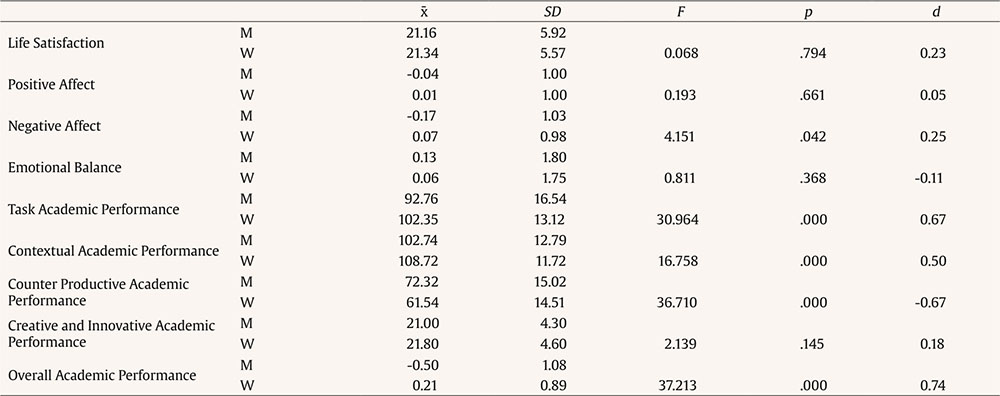 Note. N = 328 (232 are women and 96 are men); M = men; W = women; = mean; SD = standard deviation; d = Cohen’s d. Positive affect, Negative affect, Emotional Balance, and Overall Academic Performance scores are expressed in Z-scores. *p < .05, **p < .01. In relation to the components of SWB, the results indicate that there are statistically significant differences between males and females in negative affect (F = 4.151, p = .042), with females scoring higher on this variable, although the effect size is small (Cohen’s d = 0.25). These results partially support Hypothesis 2, which states that there are differences between men and women in SWB and its components, but no significant differences were found in the cognitive component. In relation to AP, the results indicate that statistically significant differences occur in the dimensions of task, contextual, counterproductive, and global academic performance. The results indicate that it is females who score higher on task, contextual and overall AP, with moderately high effect sizes (Cohen’s d of 0.67, 0.50, and 0.74, respectively). With respect to CPAP it is males who score significantly higher, with effect sizes (Cohen’s d) equal to -0.67. These results partially support Hypothesis 3 which states that there are significant differences in overall AP and its dimensions between men and women, although the difference in innovative performance was not statistically significant. Subjective Well-being, Sex, and the Prediction of Academic Performance In order to examine the fifth objective of the current study, multiple regression analyses were conducted to estimate the predictive capacity of the components of SWB to predict overall AP and its four dimensions. The cognitive and emotional components of SWB were used as independent variables in these analyses and sex was used as a control variable. The analyses were carried out using the corrected correlations reported in Table 1 because the presence of artifactual errors violates the independence-of-errors assumption and, consequently, biases the regression parameters (Schmidt & Hunter, 2015; see also, Fritz et al., 2016; Hoyle & Kenny, 1999; MacKinnon, 2008). Furthermore, to control the biases on R and R2 due to capitalization on chance, the population cross-validity coefficient (RCV) and the squared population cross-validity coefficient (R2CV) were estimated using Browne’s (1975) formula. Table 3 reports the results for predicting TAP. As can be seen, life satisfaction, positive and negative affect, and sex account for 13% of TAP variance (R = .37), the cognitive component of SWB (i.e., life satisfaction; β = .19, p = .01) and sex (β = .32, p = .00) being the only statistically significant predictors. Table 3 Multiple Regression Analysis for Predicting Task Academic Performance   Note. β = standard regression weights; R = multiple regression; R2 = squared multiple regression; RCV = population cross-validity coefficient; R2CV = squared population cross-validity coefficient. The results concerning the prediction of CAP are reported in Table 4. As in the case of TAP, the results show that the cognitive component of SWB (β = .23, p = .00) and sex (β = .23, p = .00) were the only statistically significant predictors of contextual performance in the academic context. Together, SWB and sex account for 12% of CAP variance (R = .36). Table 4 Multiple Regression Analysis for Predicting Contextual Academic Performance   Note. β = standard regression weights; R = multiple regression; R2 = squared multiple regression; RCV = population cross-validity coefficient; R2CV = squared population cross-validity coefficient. Regarding CPAP, Table 5 shows that when the life satisfaction, positive affective, negative affective, and sex are entered together in the regression analysis, they account for 20% of deviant behaviors variance in the academic context (R = .46). In this case, the four variables show statistically significant regression weights, ranging from -.38 for sex to .30 for positive affect. Table 5 Multiple Regression Analysis for Predicting Counterproductive Academic Performance   Note. β = standard regression weights; R = multiple regression; R2 = squared multiple regression; RCV = population cross-validity coefficient; R2CV = squared population cross-validity coefficient. The next multiple regression analysis (see Table 6) was carried out to estimate the capacity of SWB and sex to predict CIAP. The results show that, taken together, SWB and sex account for 8% of CIAP variance (R = .30). In this case, positive and negative affect show statistically significant regression weights (β = .31, p = .00 and β = .20, p = .02, respectively) and the regression weight is only marginally significant for life satisfaction (β = .13, p = .06). Sex was not a valid predictor of creative and innovative performance in the academic context for this sample. Table 6 Multiple Regression Analysis for Predicting Creative and Innovative Academic Performance   Note. β = standard regression weights; R = multiple regression; R2 = squared multiple regression; RCV = population cross-validity coefficient; R2CV = squared population cross-validity coefficient. Finally, Table 7 reports the results of the multiple regression analysis for predicting overall AP. As can be seen, taken together, the variables accounted for 17% of global academic performance variance (R = .42). Sex (β = .25, p = .00) and the cognitive component of SWB (β = .32, p = .00) were valid predictors of global academic performance. Table 7 Multiple Regression Analysis for Predicting Overall Academic Performance   Note. β = standard regression weights; R = multiple regression; R2 = squared multiple regression; RCV = population cross-validity coefficient; R2CV = squared population cross-validity coefficient. In recent years, both primary research and various meta-analyses have demonstrated the relevance of academic performance (AP) as an antecedent and predictor of job performance. Research has shown that the size of the validity of AP in predicting job performance is similar or superior to that of other predictors used in predicting job performance, such as personality measures, assessment centers, situational judgement tests, or conventional selection interviews, among others (see Salgado, 2025, for a review of the validity coefficients of personnel selection procedures). For this reason, as Van Iddekinge et al. (2024) have pointed out, many organizations assess the academic performance of job candidates in their recruitment processes. In this body of research, AP is usually operationalized as grade point average (GPA). However, as with job performance, AP is a multidimensional construct, which includes at least four distinct but related dimensions: task, contextual, counterproductive, and innovative. In this regard, research on the antecedents and predictors of AP and its facets is still scarce and, therefore, this study has aimed to contribute to expanding the scientific literature on AP in university students and its relationship with subjective well-being (SWB). The present research contributes to the knowledge of the relationship between SWB and AP in five different aspects related to the five research objectives. The first contribution refers to the demonstration that SWB correlates significantly with both overall AP and its dimensions, and the same is true for the components of SWB. Thus, the cognitive component of SWB (i.e., life satisfaction) and the affective component (positive affect, negative affect, and emotional balance) correlate with overall AP and with some of its dimensions. More specifically, life satisfaction correlates with all dimensions of academic performance. Positive affect correlates with contextual academic performance (CAP) and creative and innovative academic performance (CIAP). Negative affect correlates with CIAP, and emotional balance correlates with CAP and CIAP. This means that the higher the students’ SWB, the better their academic performance. A second finding is that the cognitive component seems to be a more valid predictor of AP than the affective component. That is, life satisfaction appears to influence AP more than emotions do. These results contrast with those found in studies analyzing the relationship between SWB and job performance (e.g., Salgado & Moscoso, 2022). Until now, no study had analyzed the relationship between SWB and the dimensions of AP, understood as the different cognitions, emotions, actions, and achievements showed by the student that lead to obtaining the best possible result in a subject or set of subjects (Salgado, 2007). The few studies that had been conducted with university students had measured performance as academic achievement (mainly GPA). Therefore, the present work, in addition to being a contribution to the subject, reinforces the relevance of SWB for predicting AP in all areas and is in line with the research that has highlighted the relationship of this variable with job performance (Moscoso & Salgado, 2021; Salgado & Moscoso, 2022). In this sense, from an applied point of view, educational organizations should take into account students’ SWB and adopt measures aimed at improving it as this has a direct impact on their academic success and will have consequences in their future working life (Cuadrado et al., 2024; Diener et al., 2020; Erdogan et al., 2012; Harter et al., 2020; Lado et al., 2023; Shockley et al., 2012; Walsh et al., 2018). The second contribution concerns the evidence related to possible differences between men and women in the components of SWB. The results found indicate that there are significant differences only in negative affect, with women scoring higher. It should be remembered that the results of previous literature have been inconsistent and that the literature has focused more on the cognitive component, so further research will be necessary to confirm whether the trend found in this study is confirmed. The third contribution concerns possible differences between males and females in AP and its dimensions. The results indicate significant differences in overall academic performance (AP), task academic performance (TAP), and contextual academic performance (CAP), with higher values for females. Significant differences were also found in counterproductive academic performance (CPAP), with women showing lower values. These results are in line with those found in previous research (Cuadrado et al., 2020; Voyer & Voyer 2014). In general, females show higher AP than males. However, except in the case of CPAP, in these studies GPA was used as a measure of performance and there were no previous studies which included the rest of the dimensions of AP. Therefore, the findings of this study make a relevant contribution to the literature and seem to confirm that women perform, to a greater extent, all those behaviors that contribute to better academic results. The fourth contribution concerns the capacity of SWB and sex to predict academic performance and its components. The results show that, together, both variables explain between 8% and 20% of the variance in performance. More specifically, life satisfaction and sex show a greater impact than the affective component (positive, negative, and emotional balance) on performance and its dimensions. In summary, the results of this study have highlighted the relevance of SWB in predicting AP and its dimensions in the university context and the importance of the sex variable in the relationships between SWB and AP. Limitations and Suggestions for Future Research Although the results of this study represent a contribution to knowledge in several aspects that had scarcely been studied on the relationship between SWB and AP, it should be taken into account that this is a primary study and like all primary studies it has some limitations. A first limitation has to do with the size of the sample which, although large for the purposes of the study, is not so large for appropriately comparing between men and women (with a greater number of women). We therefore suggest that further studies should be carried out, which would allow for a meta-analysis of the relationships examined in this research. A second limitation that should be taken into account is that this study was carried out with students from a Spanish university, where the participants had specific cultural values and characteristics. Therefore, it would be interesting to carry out this study in other countries with different cultures, which would allow us to examine whether national culture moderates the relationships between SWB and AP. A meta-analysis carried out by Salgado and Moscoso (2022) analyzing the relationship between SWB and job performance has shown that there are cultural differences in the magnitude of the relationship between both variables depending on the cultural context. It would be interesting to see if the same is true for AP. A third limitation has to do with the fact that this study has used a cross-sectional design, which does not allow us to establish whether the relationships are stable over time. Therefore, it would be of interest to conduct longitudinal studies that would allow to analyze the temporal stability of SWB over time. Finally, we have a suggestion which has to do with the fact that in this study we have found that the cognitive component has a greater weight in the prediction of AP than the affective component, the opposite of what was found with job performance. In this regard, we believe that it would be interesting to conduct further studies to find out whether this relationship holds and, if so, to compare it with the results found with job performance. In conclusion, the results of this study are an advance in knowledge about SWB and its relationship with AP. Further research, however, is needed to clarify its relevance in the organizational context. Conflict of Interest The authors of this article declare no conflict of interest. Authors' Contributions The authors listed in the front page have made a substantial, direct, and intellectual contribution to the paper, and approved it for publication. Funding This research was partially supported by grant PID2020-114984GB-I00 from the Spanish Ministry of Education and Innovation to Silvia Moscoso. Cite this article as: París, T., Otero, I., & Moscoso, S. (2025). Subjective well-being and the prediction of dimensions of academic performance. Journal of Work and Organizational Psychology, 41(2), 93-101. https://doi.org/10.5093/jwop2025a10 References |
Cite this article as: París, T., Otero, I., & Moscoso, S. (2025). Subjective Well-being and the Prediction of Dimensions of Academic Performance. Journal of Work and Organizational Psychology, 41(2), 93 - 101. https://doi.org/10.5093/jwop2025a10
Correspondence: taniaparis.rodriguez@usc.es (T. París).Copyright © 2025. Colegio Oficial de la Psicología de Madrid








 e-PUB
e-PUB CrossRef
CrossRef JATS
JATS
